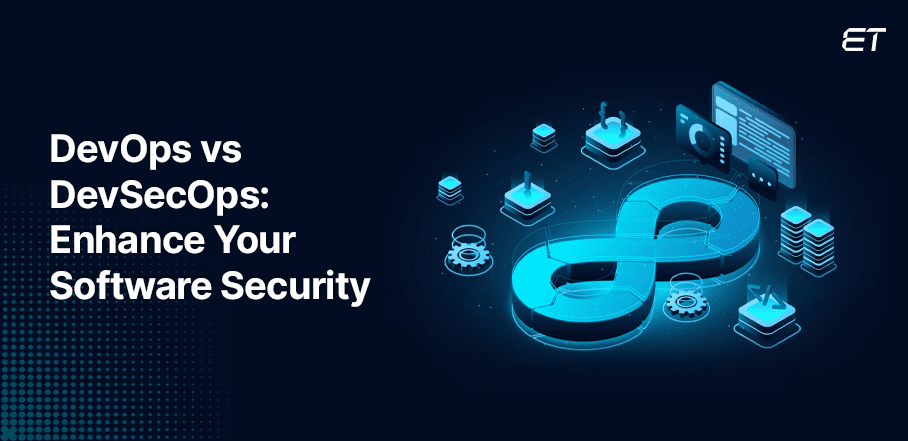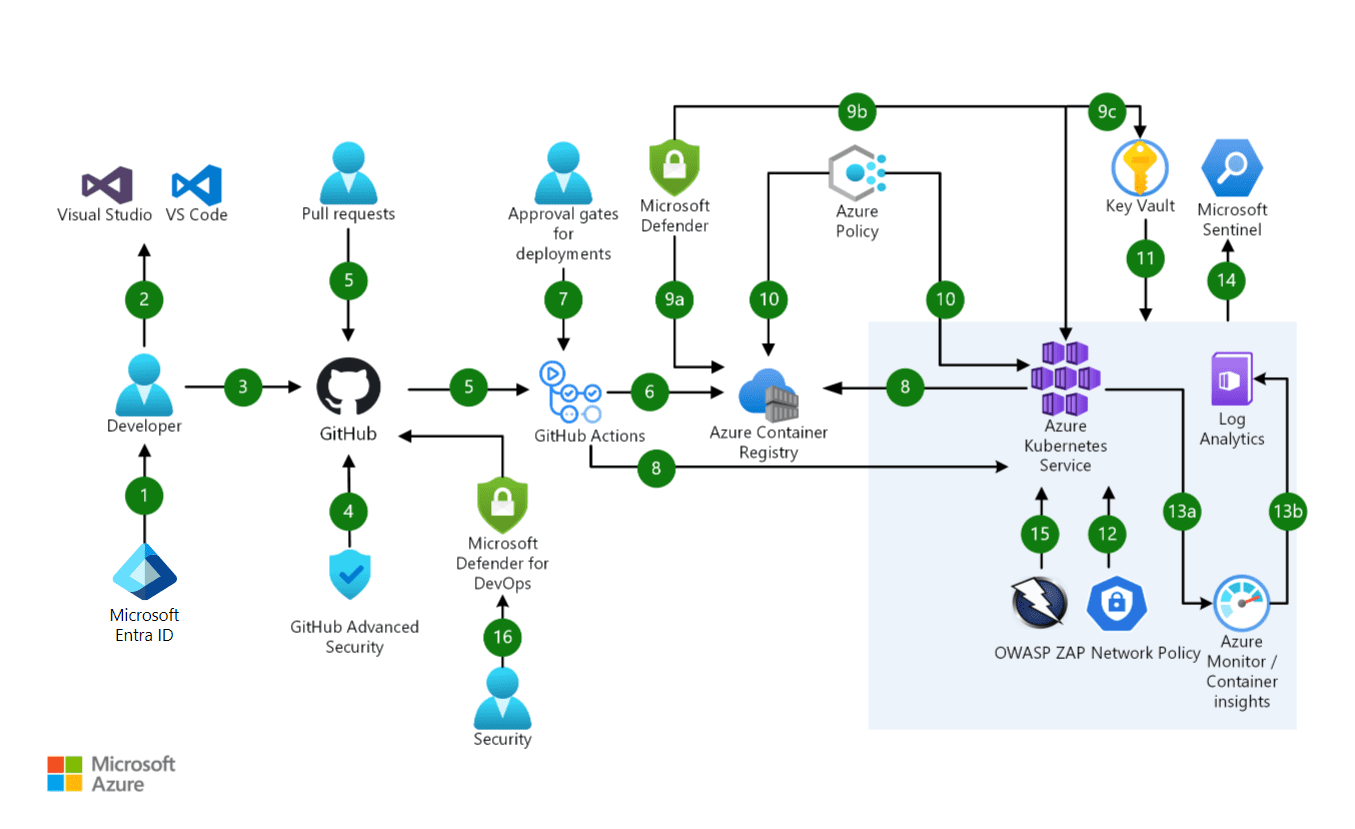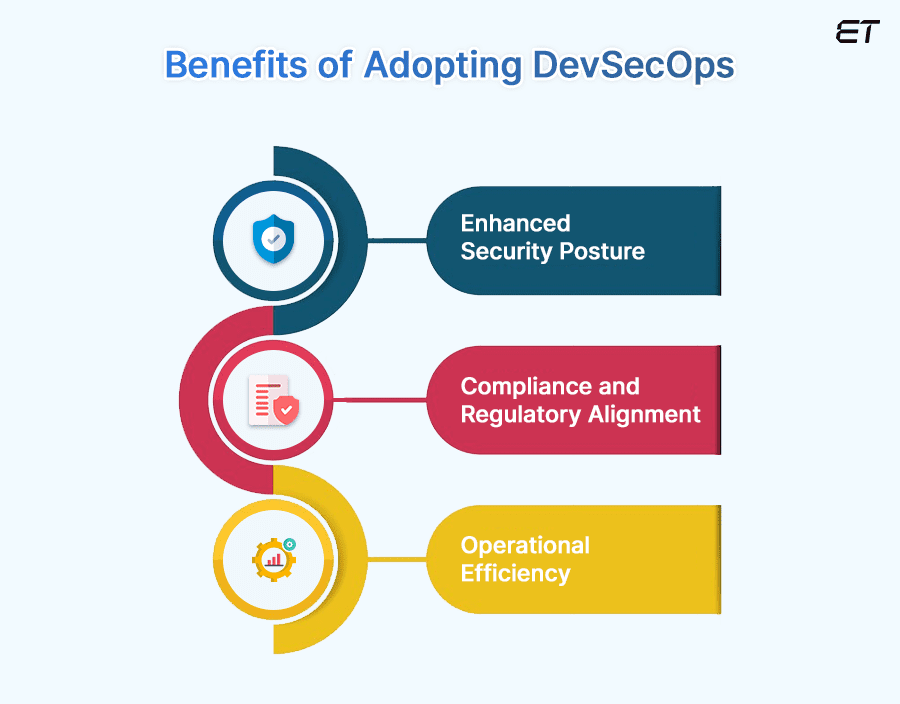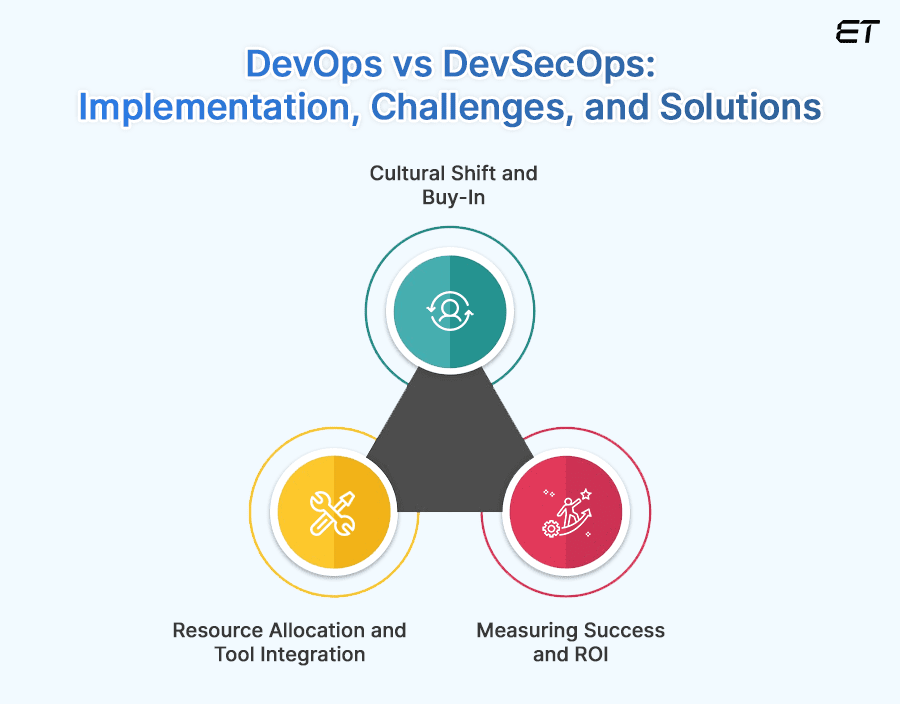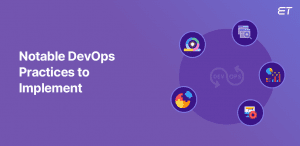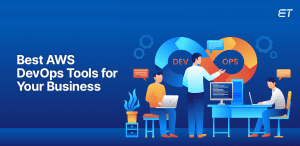A high-speed bullet train racing alongside a vintage steam locomotive—sounds captivating, right? This metaphor perfectly illustrates the dynamic clash between innovative technology and traditional systems. These outdated systems, the steam locomotives of the corporate world, are loaded with crucial data and processes. However, their clunky interfaces and obsolete frameworks hinder progress.
Does this sound familiar to you? If yes, then you’re likely wondering– is there a way to break free from this technological standstill? Absolutely! The answer lies in integrating DevSecOps into your development process.
Curious how? Read further to understand. In this blog, we will unravel the differences between DevOps vs. DevSecOps and explain why adopting the latter is vital for today’s businesses.
Nevertheless, before moving forward, let’s quickly examine what DevOps and DevSecOps mean.
Let’s get started!

Take a tour to a detailed guide to learn more about the risks involved in software development in 2024.
What is DevOps?
DevOps represents a set of practices that aim to streamline and integrate the processes of software development and IT operations. The primary goal is to shorten the system development life cycle while delivering features, fixes, and updates frequently and closely aligned with your business objectives.
Let’s have a look at its core principles below:
- Collaboration: DevOps breaks down the silos between development and operations teams, fostering a culture of collaboration and shared responsibility.
- Automation: By automating repetitive tasks, DevOps enhances efficiency and reduces the potential for human error. CI/CD pipelines are central to this process, ensuring that code is continuously integrated, tested, and deployed.
- Continuous improvement: Feedback loops are integral, allowing teams to monitor and improve their processes and products continuously.
What is DevSecOps?
While DevOps focuses on speed and efficiency, DevSecOps introduces security into the former from the start. DevSecOps ensures that security is not an afterthought but a core component integrated into your software development lifecycle (SDLC) phase.
Let’s have a look at its core principles below:
- Shift Left Security: Security is integrated early in the development process, allowing teams to identify and address vulnerabilities before they escalate.
- Continuous Security: Security measures are built into the CI/CD pipeline, ensuring ongoing protection and compliance.
- Shared Responsibility: Security is a collective responsibility, with development, operations, and security teams working collaboratively to safeguard the software.





Want to learn more about software development methodologies? Click here to read.
Differences Between DevOps vs DevSecOps
Now, we will come to the main question– What are the key differences between DevOps and DevSecOps? Let’s take a look at the table below for a clear understanding:
| Aspect | DevOps | DevSecOps |
| Focus | Primary focus is on operational efficiency and speed delivery | Primary focus is security and compliance along with resilient software delivery |
| Security Integration | Security is often considered towards the end of the development cycle, potentially leading to vulnerabilities after deployment | Security is embedded from the outset, ensuring that vulnerabilities are identified and mitigated early in the SDLC |
| Team Involvement | Operations and development teams work together, breaking down traditional silos to improve efficiency | Extends this collaboration to include security teams, fostering a culture where security is a shared responsibility |
| Automation | CI/CD pipelines, automating development and deployment | Adds automated security testing and compliance checks |
| Risk Management | Focuses on operational risks and efficiency | Integrates risk management and compliance from the outset |
| Cultural Shift | Breaks down silos between Development and Operations teams | Emphasizes security awareness and shared responsibility |
| Compliance | Often considered post-deployment | Ensures continuous compliance and regulatory alignment |
Similarities Between DevOps vs DevSecOps
You know the difference between DevOps vs DevSecOps now, but there are many similarities between them as well. Let’s take a quick look at the similarities between them for a better understanding of DevOps vs DevSecOps:
- Both share a common goal as they both aim to enhance the speed and quality of software delivery.
- Both emphasize on breaking down silos between development and operations teams, fostering a culture of shared responsibility and collaboration.
- Utilize automation to streamline processes from code integration to deployment, leading to faster and more reliable software software releases.
- Both rely on continuous integration and continuous delivery (CI/CD) to ensure rapid and safe code changes.
- DevSecOps builds on DevOps by integrating security measures into the workflow, treating security as a fundamental aspect of the development process.
Benefits of Adopting DevSecOps
Without much ado, we will now discuss why DevSecOps and how it is beneficial for your business.
Enhanced Security Posture
As you know, DevSecOps integrates security throughout the process, reducing vulnerabilities and accelerating remediation times. This proactive measure ensures that security has a stronger posture and effectively mitigates risks.
Compliance and Regulatory Alignment
DevSecOps ensures continuous compliance with industry regulations and standards, simplifying the audit process and reducing the risk of non-compliance penalties.
Operational Efficiency
What makes DevSecOps bright and stand out from DevOps is that while adding security measures, it also maintains the efficiency benefits of DevOps by automating security checks and integrating them seamlessly into the CI/CD pipeline. This approach allows organizations to deliver secure software quickly and reliably.





Transform your DevOPs practices with integrated security. Learn now.
DevOps vs DevSecOps: Implementation, Challenges, and Solutions
As a decision maker, you must know how to implement DevSecOps, what challenges will arise, and what solutions to pursue. Read further to ensure a seamless implementation of DevSecOps in your organization.
Cultural Shift and Buy-In
Implementing DevSecOps requires a cultural shift where security becomes everyone’s responsibility. Therefore, you need to foster a security-first mindset and provide continuous training to all the team members within the organization.
Resource Allocation and Tool Integration
Integrating security tools within existing DevOps can be challenging. Thus, make sure to balance budget constraints with the need for comprehensive security solutions. Choosing the right tools and ensuring they work seamlessly with the existing system is crucial.
Measuring Success and ROI
To measure the success of DevSecOps, substantiate key performance indicators (KPIs) such as the number of vulnerabilities detected and resolved, compliance audit results, and overall software delivery time. By demonstrating the ROI through reduced incidents and compliance costs, you can justify the investment in DevSecOps.
Successful DevSecOps Implementation Example
Now that we have discussed DevOps vs. DevSecOps and which one to choose, let’s witness a real-world example that has implemented DevSecOps.
Many leading enterprises have successfully adopted DevSecOps, resulting in improved security and operational efficiency. One of them is Adobe.
Adobe adopted DevSecOps to enhance its software security by integrating security measures into its CI/CD pipelines and development processes. They implemented automated security checks, fostered a collaborative culture among security, development, and operations teams, and moved security considerations to their earliest stages of development. This approach significantly reduced its security incident response time and improved its software security. This strategy of Adobe illustrates the effective integration of security without compromising development speed and efficiency.
Apart from this, DevSecOps is beneficial in highly regulated industries such as finance and healthcare. These industries require stringent security and compliance measures, and DevSecOps ensures that these requirements are met without any compromise on speed and efficiency.





Secure your development process with DevSecOps. Get in touch with us to learn how.
DevOps vs DevSecOps: Which One to Choose?
DevOps and DevSecOps are essential methodologies in modern software development as each offers unique benefits.
While DevOps focuses on speed and operational efficiency, DevSecOps integrates security into the development process to ensure secure and compliant software delivery.
If you’re looking to balance speed with security, adopting DevSecOps is a strategic move. It will enhance your system’s overall security posture and ensure regulatory compliance.
Want to learn more about how you can integrate DevSecOps for your organization? Connect with us now, and we will strategize your move towards it according to your industry.
Frequently Asked Questions
1. What is the main difference between DevOps and DevSecOps?
The main difference between DevOps and DevSecOps is the integration of security. DevOps focuses on collaboration and efficiency between development and operations, while DevSecOps incorporates security practices from the start of the development cycle to ensure continuous security.
2. Why is security integration important in DevSecOps?
Security integration in DevSecOps helps identify and mitigate vulnerabilities early in the development process, reducing risks and ensuring compliance with industry standards.
3. Can DevSecOps slow down the development process?
The answer is ‘no’. It might seem like adding security could slow things down, however, DevSecOps aims to automate security checks within the CI/CD pipeline, maintaining efficiency while enhancing security.
4. What tools are used in DevSecOps?
DevSecOps uses tools like SonarQube for code analysis, Checkmarx for vulnerability scanning, and SIEM systems for security monitoring.
5. Who should adopt DevSecOps?
Organizations that prioritize both speed and security, especially those in regulated industries like finance and healthcare, should consider adopting DevSecOps to enhance their software development practices.
6. How to Transition from DevOps to DevSecOps?
Transitioning from DevOps to DevSecOps involves integrating security into every stage of the development lifecycle like educating your team on security best practices, incorporating automated security testing tools, and fostering collaboration between developers, operations, and security teams.
Excellence-driven professional with 15+ years of experience in increasing productivity, and revenue, while effectively managing products of all sizes. He has worked for international clients in the US, UK, and Singapore and local companies in various domains. With excellent attention to detail and a methodical approach to execution, he is an expert in bringing projects to a successful stage. He follows James Humes’s famous saying- “The art of communication is the language of leadership.”
